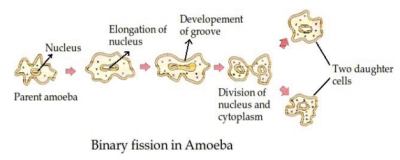How Do Organisms Reproduce Class 10 Notes
Class 10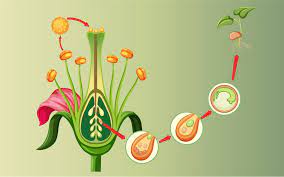
How Do Organisms Reproduce Class 10 Notes- The process of reproduction in organisms is a fundamental aspect of biology, and it involves various mechanisms and structures that enable the continuity of life. Organisms reproduce by several methods such as asexual and sexual reproduction.
Asexual Reproduction- How Do Organisms Reproduce Class 10 Notes
Asexual reproduction involves only one parent and does not require the formation and fusion of gametes. The offspring produced are almost identical to both the parent and each other. Asexual reproduction typically occurs during favorable environmental conditions and when there is an abundance of food. It is a faster method of reproduction compared to sexual reproduction.
Types of Asexual Reproduction is Unicellular Organism
(i) Binary Fission: Bacteria and protozoa such as Amoeba and Paramecium exhibit binary fission. During this process, the first pseudopodia are withdrawn (karyokinesis), and the nucleus of the parent cell divides, followed by the division of the cytoplasm (cytokinesis), resulting in the formation of two daughter cells. Binary fission occurs during highly favorable conditions, and cell division can occur in any plane, as in the case of Amoeba. In some organisms, such as Leishmania, which cause Kala-azar and have a whip-like flagella at one end, binary fission occurs in a definite orientation in relation to the flagellum.
Cytokinesis: Division of cytoplasm.
Karyokinesis: Division of Nucleus.
(ii) Multiple Fission: Plasmodium, a malarial parasite, exhibits a form of asexual reproduction. During unfavorable conditions, the parent cell develops a thick resistant wall around itself to form a cyst. Within the wall, the cytoplasm undergoes multiple divisions to form many plasmodia. When conditions become favorable, the cyst wall breaks, and the Plasmodium are released.
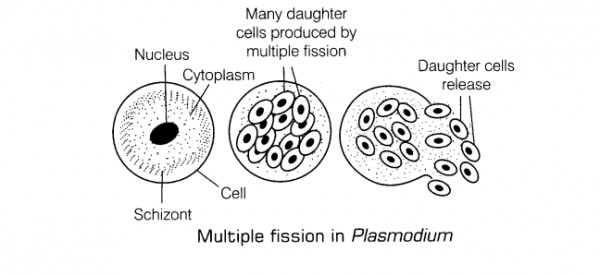
(iii) Budding: Yeast, a fungus, exhibits a form of asexual reproduction. The parent yeast cell develops a protrusion or an outgrowth at its upper end. One of the nuclei of the parent cell divides and moves into the outgrowth, which grows bigger and eventually separates from the parent cell to lead an independent existence. Under highly favorable conditions, a chain of buds is often formed.
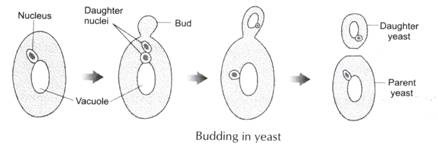
Types of Asexual Reproduction in Multicellular Organisms -How Do Organisms Reproduce Class 10 Notes
(i) Fragmentation: Spirogyra exhibits cell-by-cell division, where each fragment of the filamentous body has the potential to regenerate into a new individual. However, in multicellular organisms with more complex body organization, such as those with tissues that form organs at specific positions in the body, more complex methods of reproduction are required.
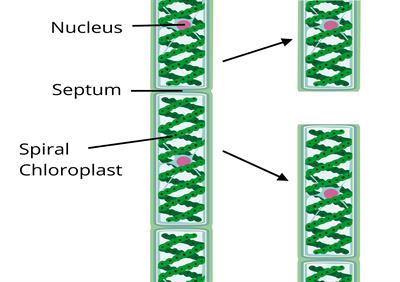
(ii) Regeneration: Organisms possess the ability to develop their lost parts, which is known as regeneration. Some organisms, such as Planaria, exhibit high regenerative capacity, which is also a means of reproduction. Specialized cells are responsible for regeneration by redividing to form a mass of cells. Different cells undergo changes to become different cell types and tissues, and these changes occur in an organized sequence known as development.
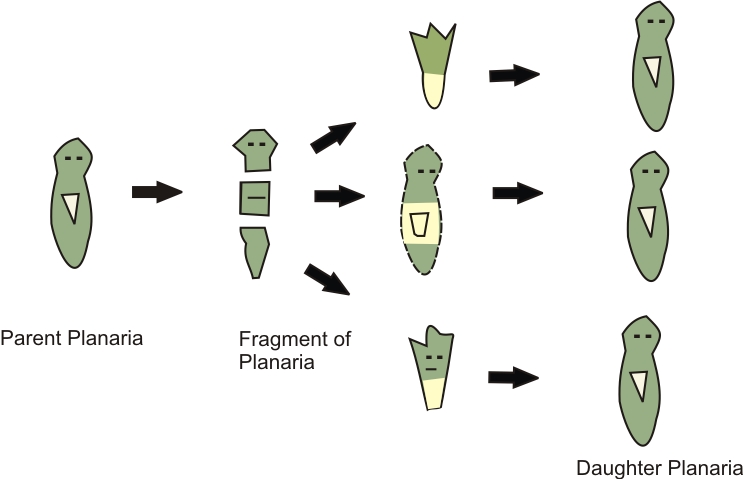
(iii) Budding: Seen in Hydra. Parent Hydra develops a bud at its lower end. This grows in size and finally breaks off to live independently.
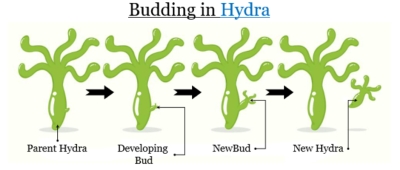
(iv) Spore Formation: Rhizopus, a fungus, has thread-like structures called hyphae that make up its body. The sporangia inside the erect hyphae form reproductive structures called spores. Spores are asexual and have a thick protective wall. They help the fungus survive during unfavourable times. When the spores land on a suitable surface, they form new individuals.
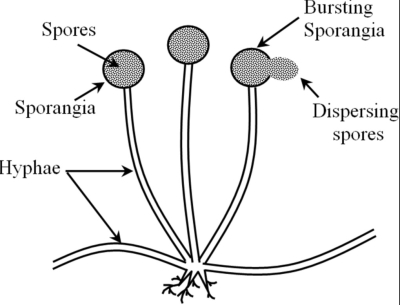
(v) Vegetative Propagation: Plants reproduce through their vegetative parts such as roots, stems, and leaves. There are two types of vegetative propagation: natural and artificial (tissue culture). Roots enable mint to reproduce naturally, while stems allow sugarcane and jasmine to do the same. Biyophyllum reproduces through its leaves, where buds are produced in notches along the margins. When these buds fall on the soil, they develop into new plants.
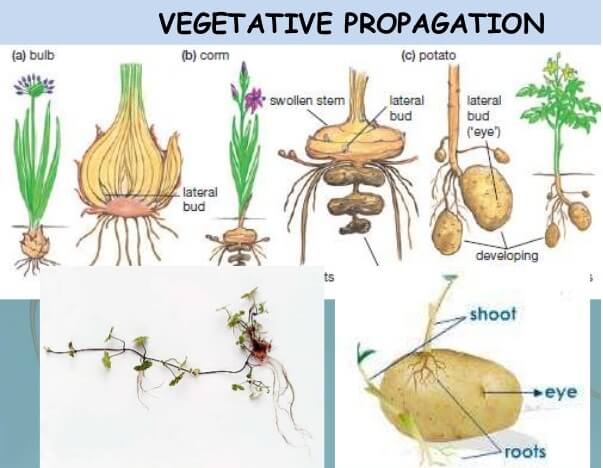
Tissue Culture: Scientists develop new plants from a cell or tissue in a nutrient medium under aseptic conditions. They place the cell or tissue in a nutrient medium, where it forms a mass of cells called callus. Then, they transfer this callus to another nutrient medium where it differentiates and forms a new plant.
Sexual Reproduction: - How Do Organisms Reproduce Class 10 Notes
- Plants and human beings can reproduce sexually.
- Sexual reproduction involves two individuals of different sexes, male and female.
- Male organisms produce male gametes called sperms, which are small and motile.
- Female organisms produce ova, which are large and store food.
- Male and female gametes fuse to form a zygote.
- The zygote develops into a new organism.
Significance of Sexual Reproduction
Plants and animals reproduce sexually by involving DNA and cellular machinery of two individuals, which leads to diversity in offspring. As gametes are produced by two different organisms, it creates new combinations of genes resulting in a higher likelihood of genetic variations. This process contributes to the emergence of new species. During sexual reproduction, the sex organs divide to reduce the DNA content by half, ensuring that the zygote formed after fertilization has the same amount of DNA as the parents and maintaining DNA consistency in a species.
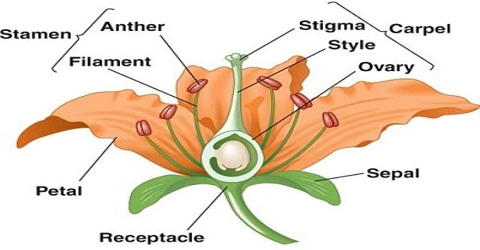
Female reproductive part
- The carpel produces ovules containing female gametes.
- It has three parts: Stigma, Style, and Ovary.
- The Stigma is the sticky top part that receives pollen grains during pollination.
- The Style is the long middle part.
- The Ovary is the swollen part that contains ovules.
- Each ovule contains an egg cell, which is the female gamete.
- The flowers may be bisexual i.e. having both stamens and carpels for example; Mustard China Rose (Hibiscus).
- The flower may be unisexual i.e. paving either stamens or carpels for example; Papaya, Watermelon.
Pollination
Pollination is the transfer of pollen grains from the anther to the stigma of a flower. There are two types of pollination: (i) Self-pollination: When the transfer of pollen grains occurs from the anther to the stigma of the same flower or another flower of the same plant. (ii) Cross-pollination: When the transfer of pollen grains takes place from the anther to the stigma of another flower of the same species or a different plant of the same species. It usually happens through agents like insects, birds, wind and water.
Fertilization in plants
The process of sexual reproduction in plants involves fertilization which is the fusion of male and female gametes to form a zygote. Pollination occurs first and then fertilisation occurs in the following steps:
- Pollen grains land on the stigma of the ovary.
- Pollen tubes grow out of the pollen grains and travel through the style to reach the ovary.
- The pollen tube has two male germ cells and each ovule has two polar nuclei and a female germ cell.
- One male germ cell fuses with the female germ cell to form a zygote which grows into the embryo. This fusion is known as syngamy.
- The other male germ cell fuses with two polar nuclei in a process called triple fusion.
- Double fertilisation takes place in flowering plants where two fusions occur during fertilisation.
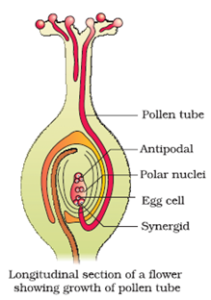
Post fertilization changes
After fertilization, the zygote divides several times and forms an embryo inside the ovule. The seed develops as the ovule forms a tough coat. The fruit forms as the ovary grows rapidly and ripens. The petals, sepals, stamens, style, and stigma shrivel and fall off.
Seed and its parts: The advantage of seed is that it protects the future plant i.e. embryo.
Seed has two parts: Cotyledons and Embryo Cotyledons store food for the future plant.
Embryo has two parts: plumule and radicle. Plumule develops into shoot and radicle develops into root.
The process of development of a seedling from the embryo under appropriate conditions is known as germination.
Reproduction in Human Being- How Do Organisms Reproduce Class 10 Notes
Human beings reproduce by sexual reproduction. The male parent produces tiny, motile gametes called sperms in large numbers from his testes. The female parent produces bigger, non-motile gametes called ova, and only one ovum is produced by one ovary per month. Sperms do not contain any stored food, while ova contain stored food. Both the gametes are microscopic unicellular and have half the number of chromosomes as compared to the body cells.
When human beings reach puberty, they become reproductively active. Puberty is a time during adolescence when the rate of general body growth slows down, and reproductive tissues start to mature. In boys, puberty starts between 11 to 13 years of age, while in girls, it starts between 10 to 12 years of age. Puberty is associated with many physical, mental, emotional, and psychological changes in boys and girls, which occur slowly over a period of time. These are called secondary sexual characteristics.
Boys develop thicker, dark hair in new parts of the body such as armpits and genital areas. Thinner hair appears on legs, arms, and face. Their skin becomes oily, and pimples may appear on the face. Boys become more conscious of their bodies, more independent, and more aggressive. They develop reproductive organs and start producing and releasing sperms. They also start growing beard and mustache, and their voice begins to crack.
Girls' breast size begins to increase, and the skin of the nipples darkens. Menstruation starts, which is the monthly shedding of the lining of the uterus. Girls become more conscious of their bodies, more independent, and more emotional.
The act of mating between the male and female partner is called copulation.
Male Reproductive System
Male reproductive system consists of the following components
Human beings reproduce by sexual reproduction. The male parent produces tiny, motile gametes called sperms in large numbers from his testes. The female parent produces bigger, non-motile gametes called ova, and only one ovum is produced by one ovary per month. Sperms do not contain any stored food, while ova contain stored food. Both the gametes are microscopic unicellular and have half the number of chromosomes as compared to the body cells.
When human beings reach puberty, they become reproductively active. Puberty is a time during adolescence when the rate of general body growth slows down, and reproductive tissues start to mature. In boys, puberty starts between 11 to 13 years of age, while in girls, it starts between 10 to 12 years of age. Puberty is associated with many physical, mental, emotional, and psychological changes in boys and girls, which occur slowly over a period of time. These are called secondary sexual characteristics.
Boys develop thicker, dark hair in new parts of the body such as armpits and genital areas. Thinner hair appears on legs, arms, and face. Their skin becomes oily, and pimples may appear on the face. Boys become more conscious of their bodies, more independent, and more aggressive. They develop reproductive organs and start producing and releasing sperms. They also start growing beard and mustache, and their voice begins to crack.
Girls' breast size begins to increase, and the skin of the nipples darkens. Menstruation starts, which is the monthly shedding of the lining of the uterus. Girls become more conscious of their bodies, more independent, and more emotional.
The act of mating between the male and female partner is called copulation.
- 1 pair of testes
- A system of ducts
- Epididymis
- Vas deferens or the sperm duct
- Urethra
- A system of glands
- Seminal vesicles
- Prostrate gland
- Cowper’s gland
- A copulatory organ called a penis.
The testes, which produce male gametes called sperms and a male reproductive hormone called testosterone, are located outside the abdominal cavity in a bag-like structure called the scrotum. This is because the testes need to be maintained at a temperature 1-3 degrees lower than the body temperature in order to produce functional sperms.
Each testis is attached to a highly coiled tube called the epididymis, where the sperms are stored and mature. The epididymis leads into the sperm duct or vas deferens, which rises up and enters the abdominal cavity. It then unites with the duct coming from the urinary bladder to form a common duct called the urethra, which passes through the penis and opens to the outside. Along the way, the ducts of the three glands also open and pour their secretions into the vas deferens.
Function of the vas-deferens: It is meant for the passage of the sperms in the male body.
Functions of the glands: They produce different secretions which provide nutrition as well as medium for locomotion to the sperms.
The secretions of the three glands along with the sperms is known as semen.
Function of the urethra: It is the common passage for both semen and urine from the body to. the outside.
Penis: It is the organ which is used to introduce semen into the female body. It is richly supplied with blood vessels.
- 1 pair of ovaries
- 1 pair of fallopian tubes or oviducts
- A uterus/womb
- A vagina/birth canal.
Each ovary is almond shaped and present inside the abdominal cavity. At the time of birth each girl child already contains thousands of immature ova. These ova start maturing only from the time of puberty. Only one ovum is produced by one ovary in one month and each ovary releases an ovum in alternate months. The release of an ovum from the ovary into the abdominal cavity is known as ovulation.
Functions of ovary
- To produce and release ova
- To produce female reproductive hormones: estrogen and progesterone.
There are two fallopian tubes. The end lying close to the ovary has finger like structures called fimbriae. The two fallopian tubes unite to form an elastic bag like structure called uterus.
Function of the fallopian tubes: It is the site of fertilization between the male and the female gametes and formation of the zygote early embryo.
The inner lining of the uterus is richly supplied with blood vessels and is known as endometrium. The narrow end of the uterus is called cervix.
Function of the uterus: The embryo formed in the fallopian tube comes down and gets attached to the endometrium (implantation) and develops for the next nine months till the baby is delivered.
Vagina: The uterus opens into the vagina through the cervix. The vagina is a muscular tube through which the baby is delivered at the end of nine months. It also serves as the canal for receiving the semen at the time of copulation.
The semen is discharged into the vaginal tract during copulation. The sperms travel upwards and reach the fallopian tube where one sperm fuses with the ovum to form the zygote. The zygote divides and redivides as it descends into the uterus and the embryo gets implanted in the endometrium. The endometrium thickens so as to receive the embryo.
The embryo gets nutrition from the mother’s blood with the help of a special tissue called placenta, which is a disk-like structure embeded in the uterine wall. It contains finger-like villi on the embryo side, while on the mother’s side blood spaces surround the villi. Villi provides a large surface area for glucose and oxygen to pass from the mother to the developing embryo and the wastes to pass from the embryo to the mother through the placenta. When the embryo starts resembling a human is formed, it is termed as a foetus. The foetus continues
to develop inside the uterus for almost nine months after which the baby is delivered as a result of rhythmic contractions of the uterine muscles.
Menstruation: It is the loss of blood, mucous along with the unfertilized ovum and the ruptured cells and tissues of the endometrium through the vagina of the female. It is a 28-day cycle which occurs in every reproductively active female (from puberty). The flow of blood continues for 2 to 8 days. If the ovum does not get fertilized, then the endometrium starts sloughing off and there is loss of blood and mucous etc. through the vagina. In case the ovum gets fertilized, then the endometrium becomes thick and spongy for nourishing the embryo and hence menstruation does not occur. A lady with a developing embryo in her womb is termed as pregnant. The beginning of menstruation at puberty is known as menarche. The stopage of menstruation when the woman is 45-55 yrs of age is called menopause.
Reproductive Health: Sexually transmitted diseases and birth control.
A number of diseases occur as a result of sexual intercourse if one of the partners is infected. These are known as sexually transmitted diseases (STD’s). They can be caused by bacteria for example; syphilis, gonorrhoea; or caused by a virus for example; HIV-AIDS, warts etc. The transmission of these diseases can be avoided by using birth control measures such as wearing a condom during the sexual act.
Birth control measures: They can be mechanical, chemical and surgical.
Mechanical methods: These are used to prevent the passage of semen to the follopian tube :
(i) Use of condoms: Condoms are thin rubber tubes worn over the penis before sexual intercourse. The semen gets collected in this and is not discharged into the vagina.
(ii) Diaphragm: It is a thin rubber fixed over a flexible metal ring which is fitted over the cervix in a woman’s body by a doctor.
(iii) Intra Uterine Contraceptive Device (IUCD) or loop: It is inserted in the uterus and its insertion causes certain secretion which prevents the implantation of the embryo in the uterine wall.
Both methods (ii) and (iii) cause side effects.
Chemical methods
- Use of spermicides: These are strong sperm-killing chemicals available in the form of creams, jellies etc. which are injected into the vagina just before copulation.
- Oral contraceptive pills: These are hormonal pills which prevent ovulation but do not stop menstruation.
Surgical methods
- Vasectomy: It involves cutting and ligating the vas deferens in males.
- Tubectomy: It involves cutting and ligating Reproductive organs the fallopian tubes in females.
- Medical termination of pregnancy (MTP) or abortions is carried out to eliminate the developing embryo. This practice can, however, be misused to carry out female foeticide which involves the killing of the female foetus. It should be avoided at all cost as it disturbs the male-female ratio in a population.
Reproduction: It is the process by which living organisms produce new individuals similar to themselves.
- Reproduction ensured continuity of life on earth.
- It is a bridge to hereditary transmission.
- It involves a continuation of characters from the parents to daughter cells by copying of DNA (Deoxyribose Nucleic Acid) molecules present in the chromosomes of the cell.
- Copying of DNAs is also not a foolproof exercise, even minute changes bring about variation in the blue print of the offsprings.
- The useful variations are retained while the harmful ones do not go beyond.
- Actually, variations help the species to withstand drastic environmental changes, thus save the species from becoming extinct and promotes its survival for a longer time.
- This inbuilt tendency of variation is the “basis” for Evolution.
Download the eSaral App for complete Class 10 Video lectures, Study material, revision and much more.
How Do Organisms Reproduce Class 10 Notes

